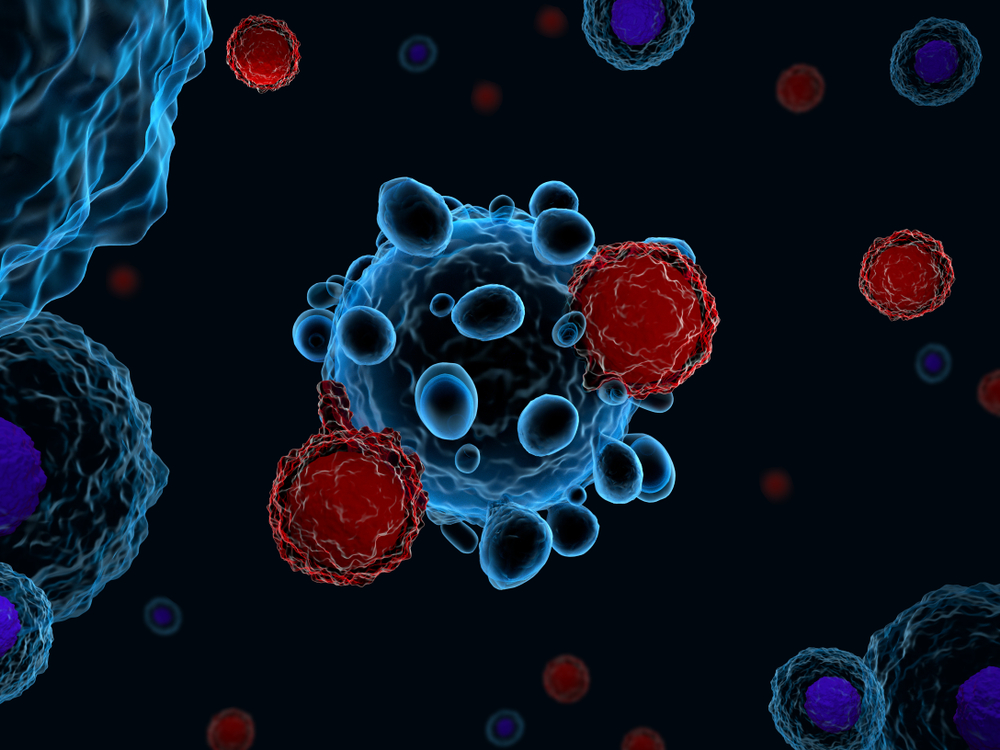Ocrevus Targets Pro-inflammatory T-cells, Not Just B-cells, in PPMS, Study Finds
Written by |

In addition to significantly reducing subsets of B-cells — its main immune cell target — Ocrevus (ocrelizumab) lessens pro-inflammatory immune T-cells in people with primary progressive multiple sclerosis (PPMS), a small study shows.
Notably, the suppression of immune cell subsets thought to be involved in the abnormal immune responses seen in MS patients was accompanied by a clear drop in the levels of serum neurofilament light chain (sNfL), a biomarker of nerve cell damage.
These findings help to further understand the mechanisms behind Ocrevus’ therapeutic benefits in MS patients, the researchers noted.
The study, “Effect of Ocrelizumab in Blood Leukocytes of Patients With Primary Progressive MS,” was published in the journal Neurology: Neuroimmunology & Neuroinflammation.
An autoimmune disease, MS is caused by the immune system mistakenly attacking the protective myelin sheath that covers nerve fibers.
Read more about Ocrevus for treating MS
Autoreactive immune T-cells that wrongly recognize myelin as foreign drive pro-inflammatory responses and immune attacks against it, with the help of B-cells. B-cells are a type of immune cell that, when activated into plasma cells, produce antibodies — also called immunoglobulins or Ig — against specific foreign molecules.
Genentech’s Ocrevus is the first and only approved therapy in the U.S. and the European Union for PPMS. Its dosing schedule involves two 300 mg intravenous (into-the-vein) infusions, given two weeks apart, followed by 600 mg infusions every six months.
The therapy works by targeting and subsequently killing cells that have the CD20 protein at their surface. CD20 is highly present at the surface of inactive B-cells and memory B-cells, but not in stem cells, which give rise to all immune cells, nor antibody-producing plasma cells.
Notably, CD20 also is found at the surface of a highly activated subset of T-cells, characterized by the increased production of pro-inflammatory molecules.
While a large number of studies have shown that Ocrevus significantly reduces CD20-positive B-cell subsets, its effects on other immune cells, including T-cells, have not been fully explored, especially in PPMS patients.
Now, researchers in Spain analyzed subsets of immune cells prior to the first dose of Ocrevus (at baseline) and after six months in 53 people — 30 men and 23 women — with PPMS.
Selected immune cells included different subsets of B-cells and T-cells. The team also assessed changes in the levels of Igs and sNfL, which serves as a biomarker of nerve cell injury.
The participants, who started Ocrevus treatment at 10 university hospitals, had a median age of 52 and had been living with the disease for a median of 8.8 years. Available MRI data from 48 patients at baseline, or the study’s start, showed that 25% had at least one contrast-enhancing, or active, lesion.
The results showed that Ocrevus led to a drastic depletion of inactive (naive) and memory B-cells and a trend toward a drop in the number of plasma cells.
The researchers noted that, if confirmed in a larger patient population, this reduction in low-CD20 plasma cells is very relevant, as these cells contribute to inflammatory and immune responses that drive MS neurodegeneration.
In addition, six months after the first Ocrevus dose, patients showed a significant reduction in the highly activated, pro-inflammatory, CD20-positive T-cell subset, as well as a drop in activated T-cells and an increase in inactive T-cells.
Patients also showed a significant drop in pro-inflammatory B- and T-cells subsets and a significant increase in anti-inflammatory, regulatory B- and T-cells, which work by dampening immune responses.
The data suggest that Ocrevus promotes a shift toward an anti-inflammatory, immunosuppressive state, which may explain its clinical benefits in PPMS patients.
However, some subsets of pro-inflammatory B-cells were increased, indicating that some B-cells can “promptly arise” after Ocrevus treatment and that “anti-CD20 treatment does not reconstitute a fully healthy immune system or re-establish immune tolerance in all patients, supporting the need for retreatment,” the team wrote.
These changes in immune cell subsets also were associated with a significant reduction in sNfL levels, specifically in patients with active lesions at baseline and in those without active lesions but with high baseline sNfL levels. These findings suggest that such patients “still could have some inflammatory activity that can be modulated on ocrelizumab treatment,” the researchers wrote.
Moreover, Ocrevus led to a significant drop in the levels of IgM, a type of Ig shown to be suppressed also by other anti-CD20 treatments, “but no patient reached levels below the normal range,” the researchers added.
Taken together, these findings highlighted that “in addition to its impact on B cells, [Ocrevus] can reshape the T-cell response toward a low inflammatory profile and induce a clear decrease in sNfL levels,” the researchers wrote. They noted, however, that larger studies are needed to confirm these results.





